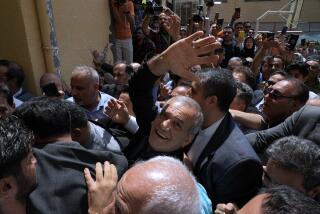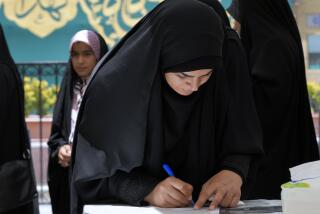Mideast hanging on every text and tweet from Iran
CAIRO — Footage of burning cars, masked boys and bloodied protesters in Iran is playing across the Middle East, captivating Arab countries where repressive regimes have for years been arresting political bloggers and cyberspace dissidents.
Egypt, Saudi Arabia and other Sunni nations have tense relations with President Mahmoud Ahmadinejad and the Shiite-led theocracy ruling Iran. But they don’t want protests in Tehran to inspire similar democratic fervor in their countries -- especially the merging of Facebook and Twitter with a potent opposition leader like Iran’s presidential challenger, Mir-Hossein Mousavi.
So far, that has yet to happen. Egyptian activists, for example, have called for rallies and strikes on Internet social networks over the last year, but they have no galvanizing personality and are too disorganized to pose a threat to the police state controlled by President Hosni Mubarak.
“I don’t think similar events could even take place in Egypt or other Arab countries,” said Ibrahim Issa, editor of the Cairo independent newspaper Al Dustour, who has been arrested a number of times for criticizing the Mubarak government. “We hope and we always keep faith that what’s happening in Iran could push Arabs to try and do the same against their oppressive regimes. But reality tells us that this is not applicable. We are comparing 30 years of what I can call Iranian democracy to 30 years of Egyptian tyranny.”
The Middle East is witnessing Iran slip into a guerrilla-style Internet and Twitter game of strategies and slogans pecked out by protesters attempting to outflank a government that has largely shut down communication outlets, leaving the nation breathless on snippets of text and stealthily uploaded pictures.
It is a battle on the streets and across the airways, a realm where technology is both churning out and smothering polarizing messages and images. Iranian authorities have blocked opposition websites, jammed satellite TV channels and cut off text messaging. But still, word is trickling beyond the censors, linking, however sparsely, protesters from Tehran to those elsewhere in the country.
Tweets by StopAhmadi are both philosophical and terse:
“In a time of universal deceit, telling the truth becomes a revolutionary act. Over n’ out.”
“Girl shot in Tehran.”
Persiankiwi’s tweets list updates of police movements and arrests: “Our street is quiet now -- we cannot move tonight but must move asap when dawn starts.”
Iran is offering an intriguing glimpse into how years of disillusionment can suddenly leap from cafes and university campuses to a national revolt, where dueling political voices and agendas square off with banners, rhetoric and allegations of election fraud.
The Iranian elections have “imposed themselves on everything. The masses of young men, the noticeable presence of young women -- especially female university students -- and the slogans of change, the intense competition that raged,” Mohammad Hussein al-Yusifi wrote in the Kuwait daily Awan. “All these factors left us no possibility but to observe closely what is happening on the Iranian scene.”
The characters in that tumult, appearing amid videos of tear gas and baton-swinging police, have provided alluring narratives: presidential challenger Mousavi, whose Facebook fan group has about 50,000 members, standing amid throngs of his supporters; Ahmadinejad proclaiming victory and calling for calm; and the hovering visage of supreme leader Ayatollah Ali Khamenei. Each is mentioned on Twitter missives bristling with rumors about what might happen next.
But sometimes things go blank. On Tuesday, Persiankiwi’s Twitter feed, which has nearly 19,000 followers, posted this: “I must log off now -- will log on when I have more info -- need phone line -- no mobile cover, no sms, no satellite, no radio.”
Similar difficulties are encountered by international media. Teymoor Nabili, a reporter for Al Jazeera, wrote on the network’s website: “Day-by-day our ability to access any information has been slowly whittled away. . . . I am no longer allowed to take a camera out into the streets. I’m not even sure I can walk out into the streets with a mobile phone without getting into trouble.”
Activists and bloggers watching developments in Iran from afar say the protests show the promise and limits of technology in orchestrating the kind of social unrest seen in Tehran. There is also the sentiment that Iranian activists rising up against an anti-Western regime enjoy more international support than their counterparts in Arab countries where anti-democratic governments are close U.S. allies.
“A cyber war and its bloggers [can’t] carry out a revolution or overthrow a certain regime on its own,” said Wael Abbas, a blogger and human rights activist in Egypt. “Full revolution has to come from the masses in the streets.”
The huge rallies and placards in Tehran make Issa, the Cairo editor, envious: “The current Egyptian system was built on fraud while the Iranian revolution was built by the people, and that is why they are fighting for such a system,” he said. “The bottom line is that unlike Iran, we are politically dead.”
Iran’s revolutionary spirit, evident 30 years ago in the Islamic Revolution, has been unbottled again. And for the Arab world it is a lesson in resistance and a maturing democracy that may be controlled by clerics but is expressing its will in the streets and in blips of texts and tweets.
--
Amro Hassan of The Times’ Cairo Bureau and special correspondent Meris Lutz in Beirut contributed to this report.
More to Read
Sign up for Essential California
The most important California stories and recommendations in your inbox every morning.
You may occasionally receive promotional content from the Los Angeles Times.











